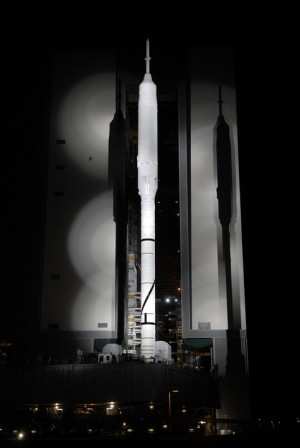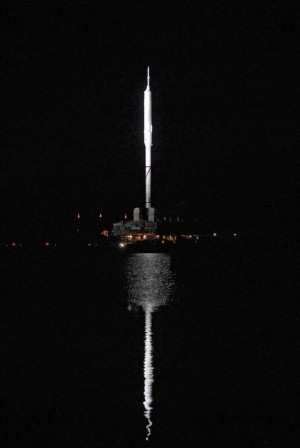Thu, Oct 22, 2009
Ares I-X Rolled Out To Launch Complex 39B
By Wes Oleszewski
 First motion of Crawler-Transporter
number 2 took place at 0139 as it snailed its way out of the
Vehicle Assembly Building's High Bay 3 at the Kennedy Space Center.
On its back was the 327 foot tall Ares I-X Development Flight Test
Vehicle.
First motion of Crawler-Transporter
number 2 took place at 0139 as it snailed its way out of the
Vehicle Assembly Building's High Bay 3 at the Kennedy Space Center.
On its back was the 327 foot tall Ares I-X Development Flight Test
Vehicle.
Hundreds of spectators were gathered at ground level. Most of
those who came to see the roll out were KSC employees, but there
was a group of hardcore spaceflight news media, waiting, cameras at
the ready.
An announcement had been made that the team involved in the roll
out operations would be turning on "The Lights" at the moment that
the launch vehicle crossed the threshold of the VAB's high bay
door. Prior to that moment the Ares I-X had been illuminated only
by the amber tint of the internal building lighting, so most of the
cameras were awaiting the moment when the "big" lights would be
turned on.

NASA Photo
As the vehicle crossed the door threshold, NASA solidified
the moment by clicking on the Xenon lights one by one. The effect
was breath taking as the true size of the Ares I-X was suddenly
highlighted. Weighing more than three empty Saturn Vs, the Ares I-X
cannot be transported with a launch tower and so must stand alone
on the mobile launcher. To the observers, the bright white vehicle
loomed into the night's sky and by the time it made the
intersection of the two crawler ways, the Xenon lights were bathing
it from three directions. On the side of the vehicle facing back
toward the VAB the Ares I-X sported a series of huge decals. On the
simulated upper stage, beginning just below the Orion adapter and
working downward was a giant American flag followed by a NASA logo,
a Constellation logo, an Ares project logo and an Ares I-X mission
patch. The first stage sports a roll stripe and markings as well as
huge "USA" in red lettering.

While the stack proceeded up the crawler way toward pad 39B, the
beams of the Xenon lights followed and crossed one another. Soon
the Ares I-X was standing alone, away from the buildings and KSC
facilities. Brilliantly illuminated, it pointed into blackness of
the night like an arrow toward the future of human spaceflight.
Finally, after nearly two hours of crawler motion, the stack had
moved beyond the service of the Xenon lights and they were turned
off, leaving the Ares I-X moving slowly into the night.

NASA Photo
By mid-morning the vehicle and the launch platform were
"hard-down" at Launch Complex 39B. Currently crews are working to
prepare the Ares I-X for its launch. Although the direction in
which the United States space program will be sent is in
unpredictable hands of the politicians in Washington DC, the Ares
I-X will soon point the way that can be taken. For now, it
represents the next generation of manned launch vehicles and will
gather the data needed to fully develop its breed. When it launches
on October 27, it will be a fiery arrow pointing the way to the
next step for NASA and for the United States.
More News
Aero Linx: Model Aeronautical Association of Australia MAAA clubs are about fun flying, camaraderie and community. For over 75 years, the MAAA has been Australia’s largest fl>[...]
Touchdown Zone Lighting Two rows of transverse light bars located symmetrically about the runway centerline normally at 100 foot intervals. The basic system extends 3,000 feet alon>[...]
“Discovery and innovation are central to our mission at Virgin Galactic. We’re excited to build on our successful record of facilitating scientific experiments in subor>[...]
How To Get A Story On Aero-TV News/Feature Programming How do I submit a story idea or lead to Aero-TV? If you would like to submit a story idea or lead, please contact Jim Campbel>[...]
Student Pilot Reported That During Rotation, “All Of A Sudden The Back Of The Plane Kicked To The Right..." Analysis: The student pilot reported that during rotation, “>[...]
 ANN's Daily Aero-Linx (05.02.24)
ANN's Daily Aero-Linx (05.02.24) ANN's Daily Aero-Term (05.02.24): Touchdown Zone Lighting
ANN's Daily Aero-Term (05.02.24): Touchdown Zone Lighting Aero-News: Quote of the Day (05.02.24)
Aero-News: Quote of the Day (05.02.24) ANN FAQ: Contributing To Aero-TV
ANN FAQ: Contributing To Aero-TV NTSB Final Report: Cirrus Design Corp SR20
NTSB Final Report: Cirrus Design Corp SR20






